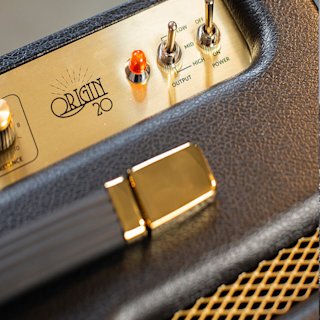A beginner's guide to setting up your guitar amp

Setting up your amp for the first time can feel intimidating, but it's much simpler than it looks, and with this step-by-step guide, we'll help you set everything up correctly so you can start playing in no time. Whether you're a beginner or just looking for a quick refresher, we've got you covered.
What you need to set up your guitar amp
Before you begin the setup process, make sure you have all the necessary equipment ready to go:
• Your Guitar – The main instrument for your sound. • Your Amplifier – Be it a combo or amp head, essential for boosting your guitar’s tone. • Speaker Cabinet (Cab) – Required if you’re using an amp head. Not needed for combo amps, as they include a built-in speaker. • Power Cable for the Amp – Make sure your amp is powered up and ready to rock. • Guitar Lead (1/4-inch Jack) – Connect your guitar to the amp with this essential cable. • Nearby Power Outlet – Ensure you have a nearby power source to plug in your amp.

Find a Good Spot
Before you start plugging anything in, place your amp in a suitable spot:
• On a stable surface, away from edges to prevent it from falling. • In a well-ventilated area to avoid overheating. Avoid tight corners or walls that block airflow. • Away from other electronics (like TVs, computers, or phones) to reduce electrical interference.
Plug Everything In
Now that your amp is in place let's connect everything: • Plug the amp's power cable into a wall outlet. Most amps need to be grounded, so make sure you're using the correct power cable. • Take your guitar lead and plug one end into your guitar. Plug the other end into your amp's input jack (usually on the front or top). • If you’re using a head and cab setup, connect them together with a speaker cable. It's essential to match the amp's impedance (the electrical resistance) with the cab's impedance (typically found on the back of both or in their manuals) to prevent damage and ensure the best sound quality.

Turn it on and adjust the settings
Now that everything's plugged in let's power up and get started:
• Turn on the amp using the power switch (usually located on the front, top, or back). • If your amp has a standby switch (common with tube amps), use it first and wait 1-2 minutes for the tubes to warm up, then turn on the power. • Set the volume low to avoid loud surprises when you power up. • Start with the EQ controls (bass, mid, treble) set to neutral (around the 12 o’clock position) and adjust from there to find your preferred sound.
Start Playing!
• With your settings adjusted, start playing and slowly increase the volume to a comfortable level. • If the sound is too bright or muddy, adjust the EQ controls to achieve a more balanced sound. • If you want more distortion or overdrive, adjust the gain control. • If your amp has built-in effects like reverb, delay, or chorus, experiment with them to see how they shape your sound.

Troubleshooting tips
If your sound isn’t quite right, try these common fixes: • No Sound? – Double-check all connections and make sure the amp is powered on. • Buzzing or Static Noise? – Swap out your guitar cable if it's damaged, or move your amp away from nearby electronics to reduce interference. • Distortion or Fuzz? – Lower the gain or adjust the tone controls. If you prefer a clean sound, make sure you’re on the clean channel.
Final tips
• Always power off the amp before unplugging cables to protect your gear and ears. • Use high-quality guitar and speaker cables for better sound and longevity. • Clean your amp regularly and store it in a cool, dry place to extend its life. • Don't be afraid to try different settings; it's all about finding and crafting your unique sound.
Now that your amp is set up, it's time to explore a world of sonic possibilities. Play around with the settings, experiment with different tones, and have fun making some serious noise!


